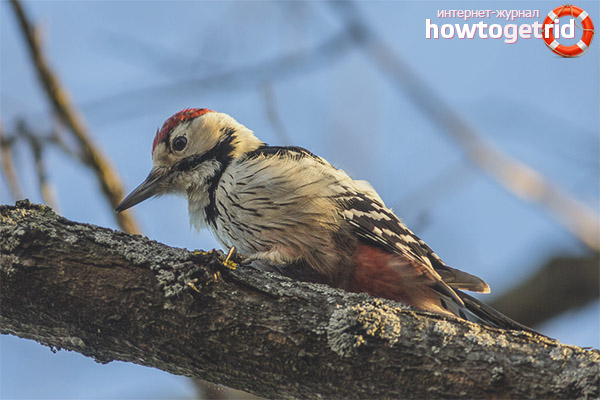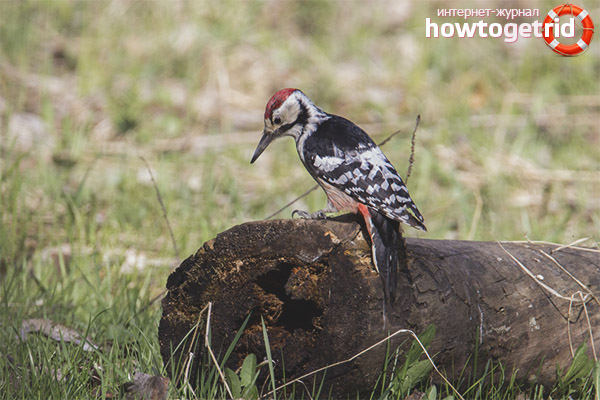The content of the article
The small white-backed woodpecker is a subspecies of the main family. The bird is very useful for the development of the forest, as it destroys populations of larvae, beetles and other pests. Killing the smallest parasites, the woodpecker prevents the destruction and decay of the tree bark, significantly extending the life of plants and the forest as a whole. The woodpecker also distributes the seeds of shrubs and trees through the digestive system, contributing to the population of the forest.
Small orderlies inhabit the bright deciduous forests of Eurasia.
Representatives belong to the genus motley, and also have about 12 different subspecies. For example, only in Siberia 2 subspecies of birds were studied, in which the white color of plumage dominates, but in the Far East, individuals of darker pigmentation.
Appearance
The body length of the white-backed woodpecker ranges from 26 to 31 centimeters, the average body weight is up to 130 g, and the wingspan is about 45 cm. The bird is considered one of the largest individuals of the entire family.
On bright males, the sides of the head and forehead are painted white, and on the top there is a red “hat” with white spots. The back of the head and the top of the back of the bird, as well as the "mustache" are darkly pigmented. The male’s abdomen and lower back are light with a hint of brown (ocher), and the sides have characteristic dark streaks. The undertail of a bright person can be characterized by a pink tint. The female is no different in appearance, but the “hat” on her head is black. The wings of representatives of the species are black and white with spots. The young growth of these birds is outwardly nondescript; they have feathers of a brown, ocher, or black hue.
White-backed woodpeckers prefer settled life on trees, then their elongated conical beak is specially adapted for extracting insects from under the wood. The skull of the bird is large and strong, which allows it to withstand loads while "knocking" on a tree. The tail of individuals has a wedge shape and includes hard feathers, which allows it to be used as a support.
Lifestyle
An inconspicuous woodpecker hides in open leafy areas. He prefers to build houses in the hollows of shabby trees with comfortable loose tree bark. Most often, he chooses a birch or aspen, forming a niche at a height of more than 10 m from the ground.
The woodpecker lives permanently in the forest, preferring to return annually to the familiar area. Just have to build a house every time a new one. By the way, male and male live separately, uniting only in the mating and breeding season of young animals.
White-backed woodpeckers are monogamous, ready for breeding at the end of the first year of life. Nesting begins earlier than the rest of the family (a surge in activity is observed in April). To search for a partner, the male begins to actively drum on the bark and branches, scream. In response, the females perform characteristic sounds, banging. Interested birds can circle around each other, making "mating" flights. After the pair is formed, the birds become aggressive towards other representatives.
The tree for organizing the nest is selected by the male, after which he hollows out a comfortable niche for more than 10 days. The height of such a hollow from the ground, as a rule, reaches 8 meters, but the depth is up to 35 cm with a diameter of 12. After mating, the female lays from 3 to 8 (less often) small white eggs. Both stalls incubate masonry for approximately 2 weeks (it was noticed that the male is in the nest longer).Already at the end of May, chicks hatch — blind, naked and helpless. Parents feed offspring, committing up to 300 acts of food transfer per day! Young growth is in the nest for about 3 weeks, after which it learns to fly independently. Even when the brood breaks up, young woodpeckers try to stay near the nest for up to 3 weeks.
Life expectancy ranges up to 8-9 years.
Nutrition and distribution

The white-backed woodpecker, depending on the habitat, prefers mixed food. Of insects and larvae, beetles, adults, ants, aphids, bugs of a caterpillar, and horntail become victims of a bird. Also, clams and crustaceans were found in the stomachs.
In winter, woodpeckers fly closer to places where people live, where they can eat on equipped feeders or garbage cans. In rare cases, a woodpecker ruins other people's nests, eats eggs, chicks and even carrion.
In the cold season, the white-backed woodpecker does not disdain seeds of cones, beech, hornbeam, oak, as well as nuts and acorns. Of the berries, birds prefer gooseberries, cherries, raspberries, junipers, currants. In spring, individuals break through the bark of a tree and drink juice.
Representatives live in the middle zone of the Eurasian continent (a mixed zone and deciduous foxes, where there are enough decaying trees). Occasionally settles in urban parks, as well as near ponds or lakes. More rarely, settlements are recorded in mountainous areas at an altitude of up to 2 km above sea level.
The bird is listed in the Red Book of some areas of the Russian Federation and Belarus.
Video: White-backed Woodpecker (Dendrocopos leucotos)










Submit